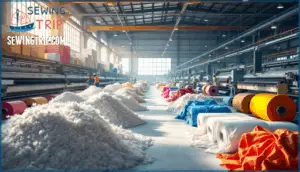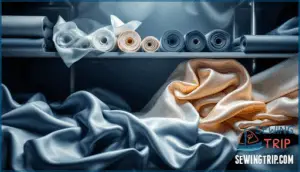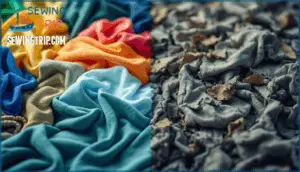This site is supported by our readers. We may earn a commission, at no cost to you, if you purchase through links.

Polyester resists wrinkles, nylon stretches without tearing, and acrylic keeps you warm without the weight. But synthetic fabrics aren’t one-size-fits-all. Understanding the different types of synthetic fabrics and their distinct properties helps you make smarter choices about what you wear, how you care for it, and what performance you can actually expect from your clothing and gear.
Table Of Contents
Key Takeaways
- Synthetic fabrics like polyester, nylon, acrylic, and spandex are engineered to outperform natural fibers in specific ways—polyester resists wrinkles, nylon stretches without tearing, and each type solves distinct performance problems depending on what you need your clothing to do.
- The production of synthetic fabrics carries serious environmental costs: polyester manufacturing alone generates roughly 700 million metric tons of CO₂-equivalent annually, while synthetic garments shed at least ten times more microplastics than cotton during washing, contributing millions of tons to oceans yearly.
- Synthetic fabrics offer real maintenance advantages over natural fibers—they handle low-temperature washing beautifully, resist wrinkles without fussing, dry quickly on low heat, and require less overall care while maintaining durability through repeated wear cycles.
- While synthetics excel at moisture-wicking and quick-drying performance for activewear, they come with health trade-offs: chemical additives and microplastic shedding raise skin sensitization concerns, and these materials persist over 200 years in landfills with less than 1% currently being recycled.
What Are Synthetic Fabrics?
Synthetic fabrics are man-made textiles created through chemical processes rather than harvested from plants or animals. They’ve transformed the way we dress and use textiles, offering performance benefits that natural fibers simply can’t match.
To understand what makes these materials so popular, let’s break down their definition, how they differ from natural options, and where you’ll find them in everyday use.
Definition and Key Characteristics
Synthetic fabrics are textiles made from man-made fibers produced through chemical synthesis, primarily using petroleum-based polymers like polyester and nylon. These materials undergo production methods such as melt spinning and polymerization, where chemical compounds form long-chain polymers with uniform material properties.
You’ll find synthetic fibers display remarkable chemical resistance, high tensile strength, and functional applications across apparel and industrial uses. Their polymer composition gives synthetic fabric characteristics like durability, wrinkle resistance, and moisture-wicking performance that distinguish them from organic textiles.
How Synthetic Fabrics Differ From Natural Fabrics
While synthetic fabrics originate from petroleum-based polymers through polymerization, natural fibres come from plants and animals. Here’s how fiber composition and properties diverge:
- Production processes: You’ll see synthetics created via chemical synthesis versus agricultural cultivation for naturals.
- Property comparison: Synthetic vs natural fibers shows tensile strength of 400–900 MPa compared to cotton’s 287–400 MPa.
- Environmental impacts and comfort factors: Synthetics resist wrinkles and shrinkage but offer lower breathability (40–80 mm/sec) than natural materials (200–400 mm/sec).
Fiber characteristics reveal synthetics absorb under 1% moisture while wool absorbs 25%. Some predict that bio-based synthetics will gain popularity.
Common Uses in Textiles and Apparel
Beyond understanding their structure, you’ll find synthetic fabrics everywhere in modern life. Apparel dominates the scene—polyester accounts for roughly 64% of global fiber production in clothing materials. You’ll spot nylon in activewear and swimwear, spandex in leggings and compression garments, and acrylic in sweaters.
Home furnishings like curtains, upholstery, and carpets rely heavily on polyester’s durability. Industrial textiles use these materials in ropes, conveyor belts, and automotive seat covers.
Even sustainable fabrics now incorporate recycled polyester, reflecting fashion trends toward eco-conscious innovation while maintaining performance advantages. These fabrics are known for their resistance to wrinkles, making them ideal for travel and frequent use.
Major Types of Synthetic Fabrics
When you’re shopping for synthetic fabrics or comparing textile options, you’ll encounter several major types that dominate the market. Each one brings distinct properties that make it suited for different applications, from everyday clothing to specialized industrial uses.
Here’s a closer look at the seven most common synthetic fabrics you’ll find in modern textiles.
Polyester
You’ll find polyester everywhere—from your workout gear to your bed sheets. As the workhorse of synthetic fabrics, polyester dominates global fiber production at roughly 78 million tonnes in 2024. Its popularity stems from wrinkle resistance, durability, and affordability.
Polyester applications span apparel, home furnishings, and technical textiles, while polyester blends combine natural fibers for enhanced performance. The polyester production market reached USD 111.61 billion in 2025, projected to hit USD 191.40 billion by 2032.
Recycled polyester is gaining traction as manufacturers address sustainability concerns without sacrificing the properties of synthetic fabrics that make this fiber indispensable.
Nylon
Regarding strength and versatility in synthetic fibers, nylon is a standout. Nylon properties include impressive durability, elasticity, and lightweight construction—making nylon applications span from hosiery to parachutes.
Nylon production reached USD 17.48 billion in 2025, projected to hit USD 26.95 billion by 2033. While nylon recycling currently represents just 1.9% of total production, nylon innovations in bio-based and recycled variants are reducing fossil fuel dependency and meeting sustainability standards.
Acrylic
When you need wool’s warmth without the price tag, acrylic delivers. Acrylic production hit USD 6.1 billion in 2025, projected to reach USD 9.2 billion by 2035.
Acrylic uses span sweaters, blankets, and home furnishings, where acrylic blends with other synthetic fibers improve durability.
Recycled acrylic and solution-dyed acrylic innovations are cutting water and chemical use, making these synthetic fabrics more sustainable while maintaining the properties of synthetic fibers you rely on.
Spandex (Elastane)
Elasticity defines spandex—this synthetic fiber stretches up to 500% and snaps back without losing shape retention. You’ll find spandex (also called elastane or Lycra) dominating sportswear applications and medical uses like compression garments.
The market hit USD 5.69 billion in 2023, racing toward USD 10.87 billion by 2030. Production capacity keeps expanding as manufacturers meet surging demand for performance fabrics that move with you.
Polypropylene
Polypropylene yarn ranks as the workhorse of synthetic fibers—lightweight, moisture-resistant, and cost-effective. You’ll spot polypropylene properties across automotive applications like seat covers and floor mats, where durability meets affordability.
The market trajectory tells the story:
- Global polypropylene yarn market reaches USD 19.1 billion in 2025, climbing to USD 31.7 billion by 2035
- Technical textiles drive 66% overall market growth through 2035
- Yarn innovations include UV-stabilized and solution-dyed variants for enhanced longevity
- Automotive interiors account for significant adoption alongside packaging sectors
- Low production costs keep polypropylene competitive against pricier synthetic fabrics
Market growth accelerates as manufacturers develop specialized polypropylene for home furnishings and industrial applications.
PVC (Polyvinyl Chloride)
PVC excels as the best waterproof option in synthetic fabrics—discovered in the 1800s but patented in 1913 for textile applications. You’ll recognize PVC properties in raincoats, waterproof bags, and protective gear where moisture resistance matters most.
This synthetic material occupies niche markets rather than mainstream apparel due to limited breathability. PVC production continues for specialized uses, though PVC alternatives like TPU gain traction in sustainable synthetic fibers.
PVC recycling remains challenging compared to other types of synthetic fabrics.
Microfiber
Microfiber—woven from ultra-fine synthetic fibers usually under 1 denier—delivers outstanding cleaning efficacy through microscopic filaments that trap dust and moisture. You’ll find microfiber applications spanning cleaning cloths, upholstery, and athletic wear where fabric properties like softness and absorbency matter.
However, environmental concerns around microplastic shedding during washing drive microfiber production toward innovations in biodegradable synthetic fabrics. Despite challenges, this category of synthetic fibers continues expanding as manufacturers balance performance with sustainability in future innovations.
Semi-Synthetic and Alternative Synthetic Fabrics
Not all synthetic fabrics start from scratch—some bridge the gap between natural and purely chemical origins. These semi-synthetic options use plant-based materials like wood pulp but transform them through chemical processing into something entirely new.
Let’s look at the fabrics that blur the line between natural and synthetic.
Rayon (Viscose)
Rayon, often called viscose or artificial silk, bridges the gap between natural and synthetic fibres—it’s made from wood pulp but requires chemical processing. The global rayon market reached USD 20.50 billion in 2024 and is growing at 6.8% annually, driven by apparel demand and sustainable rayon innovations.
- Soft and breathable: Rayon’s silky texture absorbs moisture like cotton, making it comfortable in humid weather
- Adaptable drape: You’ll find it in everything from flowing dresses to medical gauze and tire cords
- Eco-conscious evolution: Closed-loop systems now recover 99% of solvents, addressing rayon production’s environmental footprint
- Market leader: Asia Pacific produces over 60% of global viscose, powering textile manufacturing worldwide
Modal
Modal takes the rayon concept further—this beechwood-derived fabric delivers luxury softness with serious durability. Valued at USD 1.2 billion in 2023, the modal fiber market is climbing 6.11% annually through 2033, powered by Asia-Pacific’s 22% global share.
| Property | Specification | Advantage |
|---|---|---|
| Tenacity | 3–5 g/denier | Stronger wet strength than rayon |
| Moisture Absorption | High breathability | Ideal for activewear and textiles |
| Biodegradability | Fully compostable | Eco-friendly end-of-life disposal |
Modal manufacturing blends sustainability with chemistry—Austria leads with 37.48% renewable energy in production, while China’s scale dominates output. Regional production spans China, India, and Europe, where cleaner technologies reduce environmental impact.
Modal blends improve moisture-wicking in synthetic fabrics while maintaining dimensional stability through repeated washing. You’ll find modal applications in everything from athletic wear to home furnishings, often blended 50:50 with wool for choice comfort.
Lyocell (Tencel)
Where modal draws on beechwood, Lyocell (Tencel) refines the sustainable alternatives approach with its closed-loop solvent recovery system, recycling over 99% of production chemicals. You’re looking at a market expanding from USD 2.1 billion in 2025 to USD 6.0 billion by 2035, led by China’s 12.5% annual growth. Rayon and modal paved the path, but lyocell delivers prime performance:
- Fiber diameter of 10–15 µm creates remarkable softness and moisture absorption
- Tenacity reaches 35–40 cN/tex dry, maintaining strength when wet—outperforming viscose rayon by 50%
- Production costs run 30–40% higher than polyester, though sustainability offsets long-term expense
- Composite reinforcement applications leverage lyocell’s mechanical advantages in bio-based materials
Lenzing AG dominates with FSC-certified wood pulp, while staple fiber commands 62% market share across apparel, home textiles, and technical nonwovens.
Acetate
While lyocell refined sustainability through closed-loop processing, acetate fibers—derived from cellulose treated with acetic acid—take a different approach in semi-synthetic fabric types. Acetate production costs run 12–15% above polyester due to wood pulp volatility and specialized spinning equipment that demands US$ 40–50 million investments.
Despite economic challenges, the market reached USD 5.28 billion in 2024 with projected 9.0% CAGR growth through 2031, driven by textile applications in formalwear and linings where acetate’s silk-like drape shines.
Sustainability concerns ease slightly—acetate’s biodegradable nature captured 12% of bio-based textile industry share, though market trends show Asia-Pacific dominance at 23% global revenue.
Properties and Performance of Synthetic Fabrics
Synthetic fabrics are engineered to deliver specific performance benefits that natural fibers can’t always match. Understanding these core properties helps you choose the right material for your needs, whether you’re selecting activewear, upholstery, or outdoor gear.
Let’s break down the key performance characteristics that set synthetic fabrics apart.
Durability and Strength
You’ll find synthetic fabrics outperform natural fibers when durability matters. Nylon demonstrates tensile strength of 50–90 MPa and stretches up to 600% while returning to shape, showcasing remarkable elastic recovery.
Polyester offers enhanced abrasion resistance and tear resistance, maintaining integrity through repeated wear cycles. Kevlar’s tensile strength exceeds steel by five times per weight, while Cordura nylon withstands weathering effects 2–3 times longer than standard fabric types, proving synthetic fibers deliver peerless performance.
Wrinkle and Shrink Resistance
Synthetic fabrics shine when wrinkle resistance and fabric stability matter most. Fiber composition determines performance—polyester achieves wrinkle recovery rates 15–30% higher than natural fibers, while finishing treatments like resin coatings boost crease recovery by 16–20%. Heat exposure reveals durability: polyester resists shrinkage below 140°F, maintaining less than 2% dimensional change through washing cycles. Weave influence matters too—tighter constructions and microfiber polyesters outperform looser weaves by 20% in wrinkle recovery, making synthetic fibers easy to clean and exceptionally practical.
- Polyester’s thermoplastic structure delivers greater wrinkle recovery, bouncing back from creases that would permanently mark cotton or linen
- Chemical and mechanical treatments improve anti-crease performance by up to 25%, though formaldehyde-based finishes may reduce breathability
- Temperature thresholds protect shape—nylon holds form until 180°F, while polyester’s 482°F melting point ensures laundry-safe stability
- Blended fabrics balance benefits—adding spandex creates self-recovery properties, though higher natural fiber content increases shrinkage risk by 5%
- Modern nanocoatings and shape-memory polymers push boundaries further, promising wrinkle-free performance across 100+ washing cycles
Color Retention and Dyeability
Colorfastness hinges on how well synthetic fibers absorb and retain dyes. Polyester demands disperse dyes at high heat (120–135°C) to achieve deep color strength—reaching K/S values around 31.9 for rich blues and blacks. Nylon takes acid dyes readily, delivering moderate to high wash fastness, while acrylic fibers respond brilliantly to basic dyes but show moderate wash stability.
UV exposure fades most synthetics by 25% over 40 hours, yet PVC resists this remarkably well, maintaining over 90% color strength.
Fiber modifications—like easy-dye polyesters—enable vibrant coloration at lower temperatures, cutting energy use by 15–20%. Strategic dyeing processes reduce water consumption by 30%, making colorfastness both a durability factor and an environmental consideration in textile manufacturing.
Moisture-Wicking and Waterproofing
When your gear needs to perform under pressure, moisture-wicking and waterproofing technologies become critical. Polyester’s hydrophobic structure excels at transporting sweat away from skin—basic polyester dries in about 25 minutes versus 45+ for cotton. Refined microporous blends achieve 8–10 minute drying times through heightened air permeability and smooth surface textures that channel moisture efficiently.
For waterproofing, hydrostatic head ratings measure protection: coated polyester reaches 10,000+ mm, while 20,000+ mm ratings handle heavy rain and snow. Specialized coating technologies and performance blends improve both breathability and water resistance, ensuring your synthetic fabrics deliver comfort and durability in demanding conditions.
Advantages and Disadvantages of Synthetic Fabrics
Synthetic fabrics come with real tradeoffs that are worth understanding before you choose them for your wardrobe or projects. They deliver genuine advantages—durability, affordability, and easy care—that have made them the dominant choice in global textiles.
But they also bring environmental concerns and comfort considerations that deserve your attention. Here’s what you need to know about each side of the equation.
Benefits Over Natural Fibers
When you’re weighing synthetic fabrics against natural alternatives, the advantages stack up fast. Synthetics deliver enhanced cost effectiveness—polyester alone accounts for 54% of global fiber production because it’s simply cheaper to manufacture at scale.
You’ll find durability advantages that outperform natural fibers in abrasion and tensile strength tests. Wrinkle resistance means less maintenance, while weather resistance and mildew immunity protect your investment longer.
The real differentiator? Customization options. Manufacturers engineer stretch, waterproofing, and UV protection directly into fibers—consistency control that natural materials can’t match. That’s why performance features like moisture-wicking and rapid drying make synthetics your go-to for activewear and technical applications.
These benefits of synthetic fibers translate directly to value and reliability.
Environmental Impact
The production footprint tells a stark story. Polyester manufacturing alone generates roughly 700 million metric tons of CO₂-equivalent annually—about 1.5% of global emissions. That’s three times more carbon than equivalent cotton output.
Polyester manufacturing generates roughly 700 million metric tons of CO₂-equivalent annually—three times more carbon than equivalent cotton output
Beyond carbon emissions, microplastic pollution dominates: synthetic garments shed at least ten times more microplastics than cotton during washing, contributing 7.4 million metric tons yearly to oceans and ecosystems. Nylon production releases nitrous oxide with 300× the warming potential of CO₂.
Water pollution runs deep too—manufacturing consumes 90–100 liters per kilogram of fabric, while chemical effluents represent up to 20% of industrial water pollution. Most critically, these non-biodegradable materials persist over 200 years in landfills, with less than 1% recycled. Microplastics accumulate in soil and organisms, disrupting ecosystems and entering human tissue.
Sustainable alternatives and recycling innovations are essential to address these cascading environmental impacts of widespread synthetic fabric consumption.
Care and Maintenance Considerations
While synthetic fabrics sidestep many production headaches, their real advantage emerges in how you maintain them. Polyester and nylon require washing after just one or two wears because they absorb odor quickly—activewear needs cleaning after each use to prevent bacteria.
Unlike natural fibers, synthetics handle low-temperature water (30–40°C) beautifully, resist wrinkles without fussing, and dry on low heat or through air drying. Spot cleaning addresses most stains before they set.
Store them cool and dry on padded hangers to preserve shape and elasticity. The payoff? Your clothes stay fresher longer with less effort and wear.
Health and Comfort Factors
Beyond maintenance ease lies a comfort reality you need to understand. Moisture-wicking synthetics like polyester excel at pulling sweat away—up to 37% faster than cotton—keeping you dry during workouts. Their breathability runs 30–52% higher than heavy natural fabrics, enhancing airflow when you’re active.
But here’s the trade-off: skin sensitization occurs in 4–6% of children wearing synthetics versus 2–3% with natural fibers. Chemical additives and microplastic shedding raise legitimate concerns. Polyester releases roughly 496,000 microfibers per wash cycle, accumulating in your home and lungs. Odor retention persists 2.4 times longer than cotton due to hydrophobic surfaces, supporting three times more bacterial growth.
Your comfort gains performance benefits while introducing health considerations worth weighing carefully.
Frequently Asked Questions (FAQs)
What are the 5 synthetic fabrics?
The five primary synthetic fabrics are polyester, nylon, acrylic, spandex, and polypropylene.
Polyester dominates global fiber production at 57-65%, prized for durability and wrinkle resistance. Nylon offers remarkable elasticity and strength for activewear. Acrylic mimics wool affordably. Spandex provides greater stretch recovery. Polypropylene delivers lightweight water resistance for industrial applications.
What are 10 synthetic materials we use every day?
You encounter synthetic materials constantly throughout your day. Polyester dominates your wardrobe—shirts, pants, and jackets rely on its durability and color retention. Nylon appears in activewear and swimwear, delivering stretch and quick-drying performance. Acrylic keeps you warm in sweaters and blankets. Spandex blends enable your leggings’ outstanding elasticity.
Your carpet, upholstery, and outdoor gear leverage synthetic durability. Microfiber cloths clean efficiently. Even your toothbrush bristles, parachutes, and seat belts depend on these engineered materials—synthetics have become indispensable across everyday applications.
What are the four most popular synthetic fibers?
If polyester dominated 57% of global fiber production in 2024, you can bet the industry’s foundation rests on four powerhouses. Polyester leads with 78 million tonnes annually, followed by nylon at over 23 million tonnes—both driving innovation across apparel and industrial applications.
Acrylic maintains significant market presence around 109 million tonnes, while polypropylene rounds out the top tier at 66 million tonnes, growing 8–10% yearly. Together, these fibers shape how you dress, work, and live.
What is the best synthetic fabric?
There’s no single "best" synthetic fabric—it depends on your needs. Polyester dominates for cost efficiency and durability, excelling in activewear with notable moisture-wicking. Nylon offers unmatched strength for demanding applications. Acrylic provides comfort at lower cost.
Consider fabric performance, environmental concerns, and specific applications when choosing synthetic fibers for your requirements.
What are the environmental implications of using synthetic fabrics?
Synthetic fabrics carry substantial environmental costs. Manufacturing consumes 342 million barrels of oil annually, with microplastic pollution contributing 16-35% of ocean microplastics. Production generates 90 million tons of textile waste yearly—most taking decades to centuries to decompose.
Energy demands for polyester reach 60+ kWh per kilogram, while chemical use drives 20% of global water pollution.
Sustainable alternatives and biodegradable polymers offer hope for reducing this environmental impact.
Are synthetic fabrics harmful to human health?
Chemical residues like PFAS and formaldehyde in synthetic fabrics can trigger skin reactions and allergic dermatitis. Microplastic shedding from washing poses respiratory and gut health risks through inhalation and ingestion.
Endocrine-disrupting chemicals may affect hormone regulation with prolonged exposure, while textile workers face occupational respiratory concerns from manufacturing processes.
Can synthetic fabrics be recycled?
Recycling synthetic fabrics remains challenging but increasingly viable. Mechanical and chemical recycling technologies can process polyester and nylon, though fabric blends complicate recovery. Economic barriers and sorting infrastructure limitations persist, yet recycling reduces energy consumption by 59% compared to virgin production.
Emerging innovations and policy initiatives like California’s SB 707 promise widespread, circular solutions ahead.
How are synthetic fabrics produced?
Production starts with polymerization—combining monomers derived from crude oil into long polymer chains through reactions at 250°C.
You then extrude molten polymer through spinnerets via melt spinning at thousands of meters per minute. Drawing aligns and strengthens fibers, while texturizing adds bulk.
What is the difference between synthetic fabrics and natural fabrics?
Think of it this way: natural fibers come straight from nature—cotton from plants, wool from sheep—while you create synthetic fabrics entirely through chemistry in laboratories.
Natural fibers breathe and biodegrade within years; synthetics resist wrinkles and last centuries. Cotton needs massive water and land; polyester requires less water but relies on petroleum.
Natural feels soft against skin; synthetics trap heat. Each choice involves tradeoffs between comfort, durability, sustainability, and care requirements.
How are synthetic fabrics environmentally sustainable?
Synthetic fabrics are becoming more sustainable through several key approaches. Bio-based synthetics made from renewable resources like corn and soybeans cut carbon emissions up to 95% compared to petroleum-derived options. Refined dyeing methods, including supercritical CO2 technology, slash water use by 98%.
Their superior durability—lasting 20 to 200 years—means fewer replacements and lower overall consumption. Recycled polyester now represents 8% of global production, with that market projected to reach $34 billion by
Closed-loop water systems and chemical recycling innovations further reduce environmental impact. You’re seeing real momentum toward circular textile systems and sustainable alternatives.
Conclusion
Synthetic fabrics aren’t simply cheaper alternatives—they’re precision solutions engineered for specific performance demands. The list of synthetic fabric types reveals a fascinating paradox: materials designed to replace nature often outperform it.
From polyester’s wrinkle resistance to spandex’s recovery, each fabric type solves distinct problems. Your choice depends less on tradition and more on what your garment must actually do.
Master these options, and you’ll buy smarter, care better, and get exactly what you paid for.
- https://www.masterclass.com/articles/natural-vs-synthetic-fibers
- https://www.leelinebags.com/synthetic-fabric/
- https://dresslemuse.com/blogs/blog/synthetic-vs-natural-fibers
- https://meridianmillhouse.com/blogs/blog/types-of-fibers-natural-vs-synthetic
- https://www.acs.org/education/celebrating-chemistry-editions/2022-ncw/fiber-to-fabric.html
















